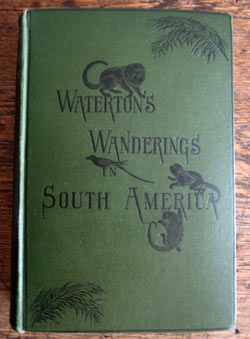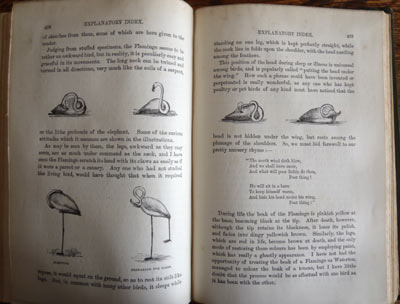Wanderings in South America
Richard Bell's Wild West Yorkshire Nature Diary, Tuesday, 4th May 2010
previous | home
page | this month | e-mail
richard | next
 SOMETIMES
I'M not sure if I'm looking out for the book or whether the book
is looking out for me. Certain titles seem to fall into my hands as if it was
meant to be. This afternoon I'd just called at Rickaro Bookshop in Horbury when
a man came in with a cardboard box of old local history books.
SOMETIMES
I'M not sure if I'm looking out for the book or whether the book
is looking out for me. Certain titles seem to fall into my hands as if it was
meant to be. This afternoon I'd just called at Rickaro Bookshop in Horbury when
a man came in with a cardboard box of old local history books.
When I saw this one, in such good condition and in its delightful
original binding, I couldn't resist it.
Charles Waterton's Wanderings in South America,
was first published in 1825 and it instantly became a bestseller, but this 1879
edition is reckoned to be one of the best of the many editions that it subsequently
went through.
A popular natural history writer of the day, the Rev.
J. G. Wood, provided a short biography of Waterton and a 140 page Explanatory
Index to the plants, birds and animals mentioned in the text. This is a real
help as Waterton often refers to a species only by its native Indian name.
 There
are numerous illustrations including engravings of the bird boxes and hides
that Waterton devised when he set about creating his own nature reserve at Walton
Park near Wakefield when he returned from his wanderings. I like the illustrations
(right) of flexibility of the flamingo's neck from the Index. There's
a touch of the Nonsense natural history of Edward Lear about them. I remember
drawing flamingoes in London zoo when I was a student and the neck ended up
looking like a tangle of pink spaghetti because the bird moved so much.
There
are numerous illustrations including engravings of the bird boxes and hides
that Waterton devised when he set about creating his own nature reserve at Walton
Park near Wakefield when he returned from his wanderings. I like the illustrations
(right) of flexibility of the flamingo's neck from the Index. There's
a touch of the Nonsense natural history of Edward Lear about them. I remember
drawing flamingoes in London zoo when I was a student and the neck ended up
looking like a tangle of pink spaghetti because the bird moved so much.
I've found Wood a fascinating author in his own right since I
wrote an essay on him as part of my college thesis. He was a great populariser
of natural history, making the best use he could of the media of the day; books
and lecture tours. I'm sure that if he'd been around in the 21st century, he
would have had his own television show.
He soon realised that however elaborate a visual aid he prepared,
it was always more effective if he drew what he was describing there and then.
On a specially designed canvas 'blackboard' stretched across a stage and lit
by limelight, he'd draw - for example - a life-size whale, to the enthusiastic
delight of the audience.
His first tour of the United States of America was a great success
but he misjudged the timing of his next tour, arriving in the year of a presidential
election. His audiences were down on the previous tour, as the country was gripped
election fever.
previous | home
page | this month | e-mail
richard | next
 SOMETIMES
I'M not sure if I'm looking out for the book or whether the book
is looking out for me. Certain titles seem to fall into my hands as if it was
meant to be. This afternoon I'd just called at Rickaro Bookshop in Horbury when
a man came in with a cardboard box of old local history books.
SOMETIMES
I'M not sure if I'm looking out for the book or whether the book
is looking out for me. Certain titles seem to fall into my hands as if it was
meant to be. This afternoon I'd just called at Rickaro Bookshop in Horbury when
a man came in with a cardboard box of old local history books. There
are numerous illustrations including engravings of the bird boxes and hides
that Waterton devised when he set about creating his own nature reserve at Walton
Park near Wakefield when he returned from his wanderings. I like the illustrations
(right) of flexibility of the flamingo's neck from the Index. There's
a touch of the Nonsense natural history of Edward Lear about them. I remember
drawing flamingoes in London zoo when I was a student and the neck ended up
looking like a tangle of pink spaghetti because the bird moved so much.
There
are numerous illustrations including engravings of the bird boxes and hides
that Waterton devised when he set about creating his own nature reserve at Walton
Park near Wakefield when he returned from his wanderings. I like the illustrations
(right) of flexibility of the flamingo's neck from the Index. There's
a touch of the Nonsense natural history of Edward Lear about them. I remember
drawing flamingoes in London zoo when I was a student and the neck ended up
looking like a tangle of pink spaghetti because the bird moved so much.